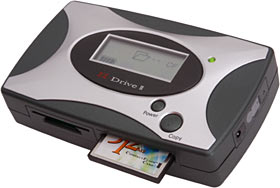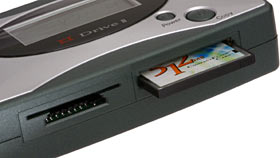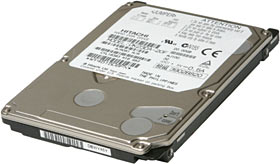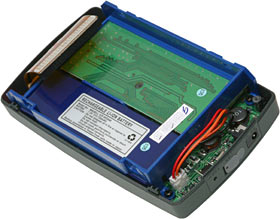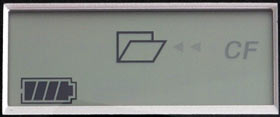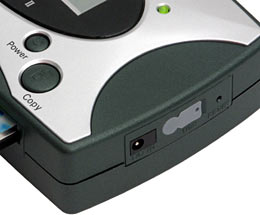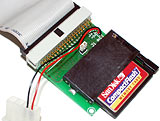
Vosonic XS-Drive II
Review date: 22 April 2003. Last modified 03-Dec-2011.
Flash memory cards are a lot less expensive than they used to be, but they're still not cheap.
Three-odd years ago, when I wrote this piece, memory cards for digital cameras and MP3 players and such cost about $US3 per megabyte. A 160Mb CompactFlash card was the largest capacity you could get.
These days, it's not hard to find 256Mb CompactFlash cards for less than $US60 and 512Mb ones for less than $US120, if you buy from the cheap dealers on the auction sites. That's less than 25 US cents per nominal megabyte.
It's a bit more per real megabyte; like other storage manufacturers, CompactFlash card makers think a megabyte is 1,000,000 bytes, not the binary-correct 1,048,576 bytes. The standards people want that to be called a "mebibyte", but it doesn't look likely to happen.
Anyway, even "1Gb" cards (likely real capacity around 980Mb) aren't stupidly expensive, and Hitachi Microdrives (which used to be IBM Microdrives, before Hitachi ate the IBM storage division) verge on actual cheapness.
Data expands to fill the space available for storage, of course, so the better-than-tenfold improvement in memory card megabytes-per-dollar isn't as great as it looks.
If someone's out of memory card space, a digital camera is the probable culprit. In early 2000, a decent digicam was likely to have 1600 by 1200-ish resolution and produce maximum quality image files around a megabyte in size, at most. Today, cameras at similar price points have resolutions up around 2400 by 1800, and spit out 3Mb files at maximum JPG quality.
And then, there's raw mode. Many "prosumer" and professional digital cameras have a raw image mode, which saves the unprocessed sensor data, for crunching into an image on the PC.
(People often call raw mode "RAW mode", but I don't know why; RAW isn't any acronym I can think of in this context, and just indicates the un-"cooked", mosaiced nature of the image data.)
Raw mode's good, because it lets you get the absolute maximum image quality out of your camera. But it's bad, because it makes really big files. My 3072 by 2048 pixel EOS D60 - which won't be an unusually high resolution digicam for long - produces raw images about 7.4 megabytes in size. Only about 66 of those will fit on a "512Mb" card.
If you're dealing with files this big - or just shooting a lot of smaller JPG images - then tons of memory cards are one solution. But something that lets you dump images to a much-cheaper-per-megabyte hard drive, then shunt them all over to your PC later, is a more attractive option.
You can do this with a laptop computer, of course; memory-card-to-PCMCIA adapters are a cheap and easy way to turn your Flash cards into removable drives on your portable computer.
But if you just want a bucket to put your images in, with no screen or keyboard or RAM or processor, you can pay a lot less. All an image bucket gadget needs is a memory card slot, a hard drive, the ability to copy from one to the other, a battery to power it while you're out and about, and some kind of computer interface for shifting the pictures on to your PC.
The "Digital Wallet", from the now-defunct Minds@Work, was the first such product; the "digital wallet" name is now somewhat generic. The most popular digital wallet around now is probably Grand-Level's Image Tank (called the "Image Bank" in the USA).
And then, there's this.
Vosonic, the makers of the above digital-wallet-thing, say that it's called an "X'S-Drive II". Regular readers will know that gratuitous intra-word punctuation is not one of my favourite things, not least because it can leave luckless shoppers failing to find the product because it's listed online as an "X'S-Drive".
So I'm calling it the XS-Drive II from now on. Vosonic should consider themselves lucky that I let them keep the hyphen.
Apart from the name, this thing looks rather promising. It can natively accept three popular kinds of memory card, and more using adapters. You can easily kit it out with a 40Gb, or even larger, hard drive. It connects to a PC via USB, and works with USB 2.0 for fast transfers. And it's quite small - a bit less than 14cm (5.5 inches) long at its longest point, around 82mm (3.25 inches) wide, and about 32mm (1.25 inches) high. So it'll fit in a baggy pocket, or without trouble in the average camera bag.
The XS-Drive II has three kinds of card slot - CompactFlash (including Microdrives), SmartMedia (SSFDC), Memory Stick (including Memory Stick Pro), and MultiMediaCard and Secure Digital cards, too.
If you need an xD card reader, you can do it; just get a CompactFlash adapter and use that slot in the XS-Drive II. You can, similarly, use an MMC/SD Card or Memory Stick in anything with a CompactFlash socket, by using an appropriate adapter.
Practically nobody needs to be able to read all of those kinds of memory card, of course. But if you want one gadget that can read cards from almost anybody's digital camera, or if you just want to make sure your digital wallet investment won't constrain your camera choice in the future, it's nice to have such a multilingual gadget.
All of those slots don't pump the price up much, at least. When I first wrote this review, Australian shoppers could buy the XS-Drive II from Aus PC Market for $AU209 delivered, however they no longer stock it (click here to see their current card readers), plus the hidden cost.
The hidden cost is the hard drive. The XS-Drive II is so cheap because it doesn't come with a drive.
You only need a standard 2.5 inch 9.5mm high laptop drive, like this 20Gb Hitachi, not a really small and expensive 1.8 incher. But you'll still probably be paying more than the XS-Drive II's individual price again for a drive to put in it.
The hard drive's easy to install; you undo a couple of screws on the bottom of the XS-Drive II, open the casing...
...then plug your drive in, and screw it into this bay. You get mounting screws with the XS-Drive II (including one spare), plus a couple of rubber feet to pop into the case screw holes when you've finished.
The XS-Drive II doesn't provide any particular shock protection for its drive, but that's OK; this is a laptop drive, so it's much tougher than a normal 3.5 inch unit. That doesn't mean you can use the XS-Drive II for ice hockey practice, but it ought to tolerate rough treatment rather better than most digital cameras.
Laptop drives have an integrated power and data ribbon cable, so there's just the one thing to plug in, and it's really quite simple to do. There are jumper pins as well, but you shouldn't have to do anything with them. This means that if you want the people at the computer gear store to do the hard drive installation for you, they ought not to charge you much.
The XS-Drive II will work with both PCs and USB-capable Macs running OS X (older Windows flavours need a driver; current ones have one built in), but the drive inside it has to be formatted using the FAT32 file system. A PC running a recent Windows flavour can do that down the USB cable, so you can install a brand new fresh-from-the-bag drive and go; you won't need to fool around with a laptop-drive-to-40-pin adapter. But Mac users will need to use a PC for formatting purposes, or get their drive pre-formatted.
As with all other hard drives, the capacity on the sticker is not the capacity your operating system will report, because of the abovementioned megabyte/mebibyte problem. The "20Gb" drive I used formats to only 18.63Gb.
Despite the more-than-7% rip-off factor, this drive still has enough space for more than 2575 raw-format images from my D60. Get a 40Gb drive and you should be set for literally thousands of raw format images from any portable digicam on the market today, and an easy 20 to 30 thousand JPEG images from just about any current "prosumer" digicam.
With the 20Gb drive installed in it, the XS-Drive II weighs a hair over 300 grams (10.6 ounces).
Here's the full XS-Drive II kit. There's a zip-up carrying pouch, with handle, to help keep muck out of the otherwise unprotected card slots, and a little switchmode AC adapter that'll run from anything between 100 and 240 volts AC. This plugpack has US-style pins, so the Australian version of the XS-Drive II comes with an adapter to let you plug it into an Aussie socket.
And there's the XS-Drive II itself, of course, plus a USB cable, some basic documentation (including a little how-to-install-a-hard-drive sheet), and a 77mm software CD for Windows 2000 and 98. You needn't bother with the CD if you're running an OS that properly understands USB Mass Storage Class devices. The XS-Drive II was plug-and-go with the built-in Windows drivers on my WinXP test machine; it's alleged to be just as good on WinME, Mac OS X and Linux 2.4 and higher.
The XS-Drive II's display is minimalist, because there's not much information it needs to impart to you. The "CF" and the two leftwards-facing triangles are faint in this picture because they're flashing; there's data being copied from a CompactFlash card to the XS-Drive II's hard drive. Different card types get different letters, but apart from that and another annunciator to tell you when the XS-Drive II can see a USB connection, there's nothing of value on the display except the battery indicator.
The battery's a 7.2V 720mAh Maxell lithium ion unit, supposed to be good for at least 500 full charge/discharge cycles, and probably good for quite a lot more of the partial cycles that most batteries deliver in real world use. It's meant to power the XS-Drive II for a bit more than an hour and a half, from a full charge. It takes about three hours to charge, from the included AC adapter.
The XS-Drive II doesn't, by the way, draw power from its USB cable, to run or to charge. You can connect it to a PC without the AC adapter, but it'll be running from battery power if you do.
Using it
You're looking at the most complex corner of the XS-Drive II. One power button, one Copy button (which you hold down if you want to cancel a copy operation), one rubber-flap-covered mini USB socket, one barrel socket for the power adapter, and one recessed poke-it-with-a-paper-clip reset button. That's pretty much it.
Simplicity isn't good just by itself, though.
Traditionally, multi-card-readers - which typically don't have any buttons or displays at all, beyond a status LED or two - have been a pain. They've generally worked, for suitably small values of "worked", but computers tended to go into spasms when they were plugged in ("Aah! Six new drives! I must load the drivers for all of them at once and play tug-of-war with myself over the files!"), using more than one card at a time was a recipe for mayhem, and multi-readers were also often a lot slower than single-slot readers. Adding an internal hard drive to one of these readers would not make things better.
The XS-Drive II, in contrast, seems to play very well with the PC. Plug it in to a WinXP machine and, after a bit of once-off thrashing while Windows figures out what's going on, you get four new removable drives.
The first drive is the XS-Drive II's hard drive. If you've installed a brand new drive in the thing then it'll be unpartitioned and unformatted, but WinXP's Disk Management console (in Control Panel -> Computer Management) makes partitioning and formatting easy enough. You just have to make sure to format the disk as FAT32, or the XS-Drive II won't be able to deal with it.
Once that's done, the XS-Drive II behaves perfectly sensibly. Stick a card in one of its slots and there's a "disk" in the appropriate removable drive. Yank the card again and there isn't. If there's more than one card in the XS-Drive II, there's more than one "disk" in the three removable drives that correspond to the card slots. No drive letters get moved around.
With the XS-Drive II connected via USB 1.1, it almost pegged the meter for both read and write speeds, using a fast CompactFlash card. That meant about 915 kilobytes per second both ways; USB 1.1's 12 megabit per second maximum bandwidth just can't transfer much more user data per second than that.
When I switched to USB 2.0, the XS-Drive II delivered data a lot faster. With the same speedy 512Mb Ritek CompactFlash card, it now managed about 4.5 megabytes per second.
Copying files from the XS-Drive II's hard drive to the PC was just as fast. Even an old 64Mb SanDisk card, the slowest in my collection, managed about 2.4 megabytes per second, and I got a 2.7Mb/s read speed from a superannuated 64Mb SmartMedia card.
(Which, by the way, it is possible to insert in the XS-Drive II upside down. This does no harm, but also conclusively stops the XS-Drive II from working properly until you get your act together and flip the card over.)
I didn't have any Memory Sticks or MMC/SD Cards handy to test, or any of the weirder formats you can jam into an XS-Drive II with a CompactFlash adapter, but I've got no reason to believe they'd be greatly slower for those. If the memory card can deliver a few megabytes per second, the XS-Drive II should let you access it that fast via USB 2.0.
This assumes that your PC has USB 2.0 ports, of course. You can upgrade older machines to USB 2.0 with a fairly inexpensive PCI adapter card.
So that was all good. Fast, simple, well behaved.
When untethered, the XS-Drive II is even easier to use. But it's not as fast as I'd hoped.
Stick a card in it, turn it on, press the Copy button, and the XS-Drive II will copy the entire card contents to its hard drive, in sequentially named directories. The first time you copy the contents of a CompactFlash card to the drive, for instance, you get a directory called CF0001; copy more stuff (or the same stuff again...) and you get CF0002. And so on.
If there's more than one card inserted, the XS-Drive II will copy the contents of each in turn, automatically. It signals the end of the copy procedure with a double beep, and it automatically turns itself off after if you leave it alone for about a minute.
The only problem with the card-to-HD copy process is that it only happens at roughly USB 1.1 speed. The XS-Drive II's USB 2 communication speed is fine, but there seems to be an internal bottleneck between the XS-Drive II's slots and its hard drive. When I tested it with different CompactFlash cards and my 64Mb SmartMedia, it only managed around 975 kilobytes per second, for everything.
That's not awful, but it'll leave you waiting a while if you want to copy the contents of a big memory card to an XS-Drive II. If you're dumping a whole "512Mb" card worth of data (487 real megabytes, in the case of my Ritek "512Mb" card) to the XS-Drive II's drive, you'll be waiting about eight minutes and 40 seconds.
From what I can see, though, that's pretty much par for the course. If there's a digital wallet product out there at the moment that's a lot faster than the XS-Drive II, I haven't been able to find it.
Even a very enthusiastic photographer isn't too likely to fill another 512Mb card in less than ten minutes, mind you. So someone with two or three large-capacity cards and an XS-Drive II should be able to keep juggling files into the XS-Drive II while shooting more photos without serious interruption.
But if the XS-Drive II were using my Ritek cards' full read speed, it'd be finished in less than a quarter of the time.
Assuming the quoted 1.6 hour battery life, you'll be able to shift less than 5500Mb of data from memory cards to the XS-Drive II per charge. That's still a whole lot of pictures, of course, but from the USB 2 transfer speed you'd expect to be able to fill a 20Gb drive without recharging. You can't.
On the plus side, the one minute auto power off means you can confidently load the XS-Drive II up with a big memory card (or with multiple cards, if you've got more than one kind), start it copying, and get on with taking more pictures. You needn't worry about the XS-Drive II sitting around turned on for no reason and wasting its batteries.
Another good feature - if you ask me - is that if you want to delete files from the XS-Drive II, you'll have to wait until you tether it to a PC. There's no delete or format button. There's a recessed reset button, in case you manage to Deeply Confuse the XS-Drive II (I did, by unplugging the USB lead when the XS-Drive II was still turned on with a SmartMedia card in it), but there's nothing that'll get rid of any files on the thing's drive unless you delete them from your computer.
Pro photographers might have a use for a digital wallet that could grab all of the files from a memory card and then automatically blank it ready for re-use, but it doesn't take a lot of imagination to see how that could go horribly wrong. Most, if not all, memory-card-using devices have a delete/format function, and the absence of such an option on the XS-Drive II is a good anti-disaster measure.
The XS-Drive II's rapid USB 2 transfer speed may or may not matter to you. If you're not moving large amounts of data very often, and especially if you can start doing stuff with the first files to transfer while you wait for the others, then you'll probably be perfectly happy with USB 1.1 speed.
With USB 1.1, though, you will be waiting the thick end of 20 minutes for every gigabyte of data you move to your PC. 30 gigabytes? More than nine and a half hours!
With USB 2.0 you'll wait less than four minutes per gigabyte; 30Gb will move in less than two hours.
The XS-Drive II's slow card-to-internal-drive speed is likely to be important to more users, if only because it'll leave you more dependent on mains power than you expected to be.
The XS-Drive II's plugpack is just a 12VDC unit, so you could easily run the thing from a car cigarette lighter, with an appropriate cable. Or, for an arguably portable solution, you could attach the same sort of cable to a standard seven amp hour 12 volt sealed lead acid battery, and probably get well over 12 hours of run time per charge. Or, if you wanted a battery that weighed less than 2.6 kilograms, you could try a couple of non-rechargeable lantern batteries in series. They'd probably run all day.
Overall
The XS-Drive II is great in every respect but one. Price good, operation simple and sensible, USB 1.1 transfer rate as good as can be expected, USB 2.0 transfer rate excellent. And it's a great multi-slot card reader, as well as a digital wallet. But its card-to-internal-Drive II speed is strangely lousy.
Not awful. Not useless. Just strangely lousy.
Almost 20 minutes per gigabyte, when copying from a memory card to the internal drive, does seem to be normal for digital wallet devices at the moment. Older models were even slower - and generally didn't work as a card reader, either - but current models do around a megabyte per second. A bit more, for some fancier units, but not a lot.
From what I can see, the XS-Drive II seems to be pretty much functionally identical to the Image Tank (or Bank) G2, except the Tank/Bank has much higher quoted copy speeds. These are, I think, a misprint.
The European Image Tank specs page at least makes a distinction between the 480 megabit per second peak bandwidth of USB 2.0 and the (presumed) megabytes per second of user file copies; the Taiwanese specs page is less clear.
But both pages quote "Card to HD" and "HD to Card" transfer rates of "16Mb/sec" and "10Mb/sec", respectively, which can't be right, simply because no current memory card technology works that fast. The cards can't accept or deliver data that quickly.
I'm betting the Image Tank people have slipped a decimal point on those pages. If so, then the current Tank is around 1.5 times as fast as the XS-Drive II.
Given the nonsensicality of the numbers, though, I wouldn't be surprised if it were exactly the same speed.
Is this thing worth buying? Yes. There doesn't seem to be anything much better on the market, the price isn't at all ridiculous for what you get (you could buy an old notebook PC for the same money, but it wouldn't be nearly as easy to use for this task), and the file copy speed problem won't actually be a problem at all for many users.
So the XS-Drive II comes Recommended from me.
Buy stuff!
Aus PC Market doesn't sell
this product any more (click
here to see their current card readers), but you can still try a price
search at
DealTime!
